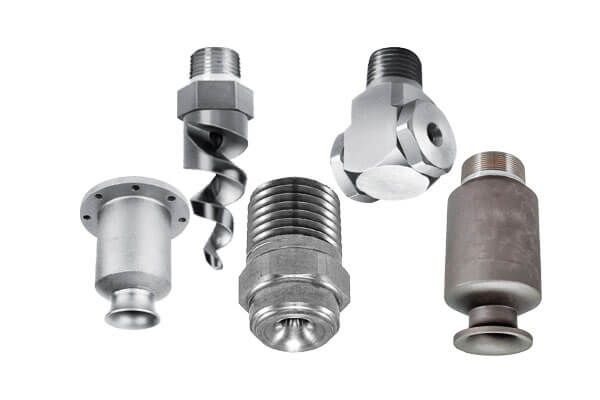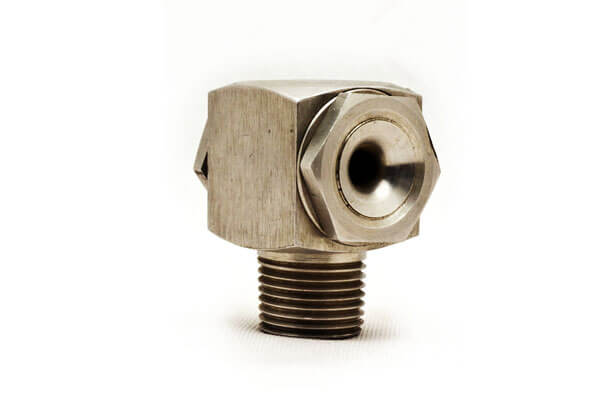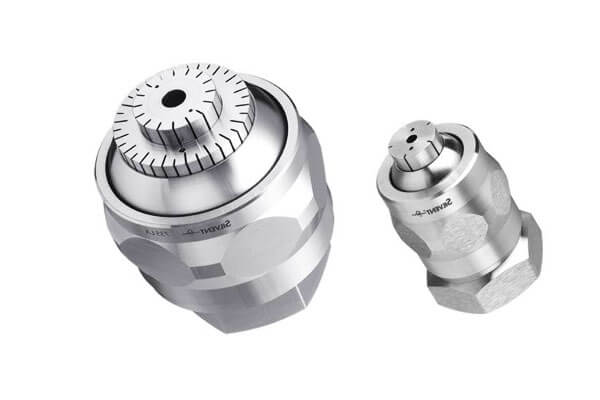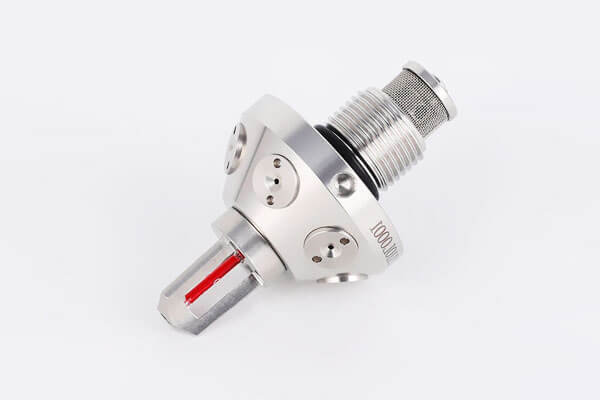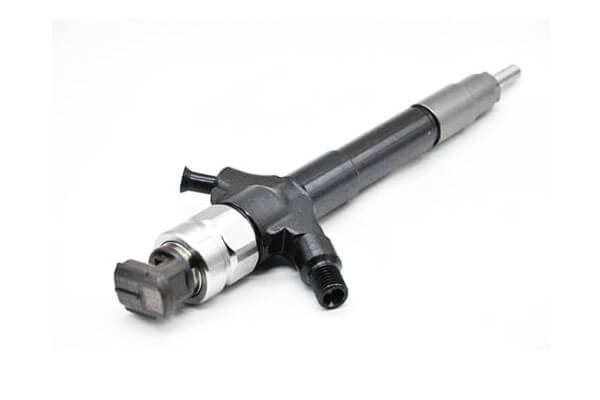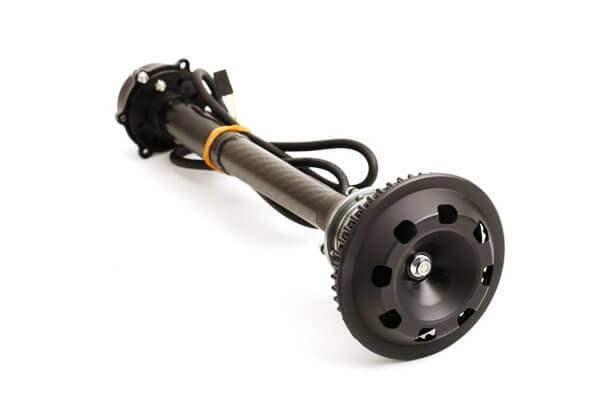1. Introduction
A nozzle is a mechanical device that directs or controls the flow of fluid (liquid or gas) within a system.
The primary purpose of a nozzle is to manipulate the velocity, pressure, and direction of a fluid to achieve desired outcomes.
By altering the nozzle geometry, the fluid’s speed can be increased or decreased, its direction can be adjusted, and its pattern can be controlled.
From powering jet engines to optimizing irrigation systems, nozzles are indispensable in industries ranging from aerospace to agriculture.
The ability to control fluid dynamics is crucial for operational efficiency, energy savings, and overall system performance.
This blog will examine the various nozzle types, the engineering principles behind them, and their broad spectrum of applications.
It also highlights innovations and future trends shaping the nozzle industry.
2. What is a Nozzle?
A nozzle is essentially a device that controls the flow of fluids by constricting or expanding the passage through which the fluid passes.
This alteration in the flow path results in changes in velocity, pressure, or direction.
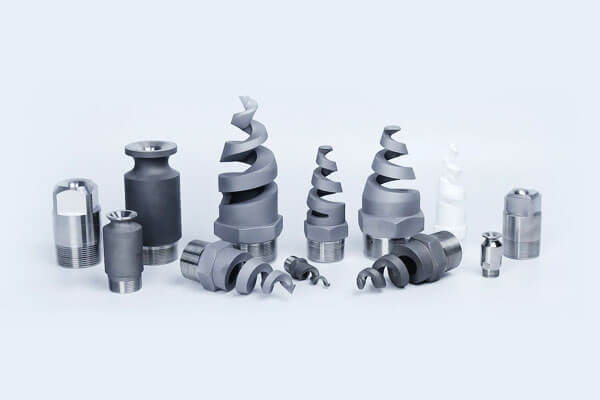
In simple terms, a nozzle transforms a high-pressure flow into a high-velocity flow, or vice versa, depending on its design.
Nozzles are commonly found in applications that require specific control over fluid behavior.
From fuel injectors in automotive engines to spray nozzles in agriculture, the nozzle’s function is pivotal in controlling how fluids are distributed and utilized.
3. Types of Nozzles
Nozzles are highly specialized components designed to manage the flow, pressure, and velocity of fluids and gases.
The design of a nozzle is directly influenced by the intended application, whether it is for propulsion, spraying, cooling, or controlling high-pressure systems.
Below, we explore the different types of nozzles and their specific roles in various industries.
Jet Nozzles
Jet nozzles are used primarily in propulsion systems where high-speed fluids or gases are essential.
These nozzles are engineered to accelerate fluid as it passes through, often resulting in a high-velocity jet that generates thrust or enhances mixing.

Types of Jet Nozzles:
- Converging Nozzles: This nozzle narrows towards the exit, causing the fluid to accelerate. They are typically used for subsonic flows, such as in gas turbines and steam engines.
- Diverging Nozzles: These nozzle is designed to expand the flow, which lowers velocity while increasing pressure.
Diverging nozzles are used less frequently but are vital for specific applications like certain combustion systems. - Converging-Diverging (de Laval) Nozzles: The most common design for supersonic applications, this nozzle accelerates fluid beyond the speed of sound.
It is widely used in rocket engines, where the rapid expansion of gases generates thrust essential for propulsion.
Applications: Jet nozzles are crucial for propulsion in jet engines, rockets, and gas turbines.
Their design allows them to manage the exhaust gases’ velocity and pressure, enabling efficient thrust generation.
Spray Nozzles
Spray nozzles are designed to break liquids into fine droplets, allowing for controlled atomization of liquids.
These nozzles are essential in applications that require uniform fluid distribution, such as in irrigation, fuel injection, and coating.
Types of Spray Patterns:
- Full Cone Nozzles: These nozzles produce a solid, cone-shaped spray pattern, offering even distribution over large areas.
Full cone nozzles are commonly used in cooling systems and irrigation, where uniform coverage is essential.Full Cone Nozzle - Hollow Cone Nozzles: Hollow cone nozzles create a circular spray pattern with a hollow center.
This pattern is ideal for cleaning, rinsing, and washing applications as it maximizes surface contact while minimizing fluid use.Hollow Cone Nozzle - Flat Fan Nozzles: These nozzles deliver a wide, flat spray pattern, commonly used in industrial cleaning, pesticide application, and agricultural spraying.
They offer uniform coverage and can adjust based on the application requirements.Flat Fan Nozzle - Round Nozzles: Round nozzles provide a circular spray with a more concentrated focus on the targeted area.
They are commonly used in applications like industrial coating or specific chemical spraying.Round Nozzle
Applications: Spray nozzles find use in various industries, including agriculture (pesticide spraying),
automotive (fuel injection), food processing (spraying flavors or coatings), and manufacturing (painting and powder coating).
Their ability to atomize liquids efficiently makes them indispensable for applications requiring precise fluid distribution.
Cooling Nozzles
Cooling nozzles are vital components in industries that operate under extreme heat conditions.
These nozzles help regulate temperatures by delivering cooling fluids directly to heat-sensitive components.
They are designed to prevent equipment failure and ensure efficient heat dissipation.
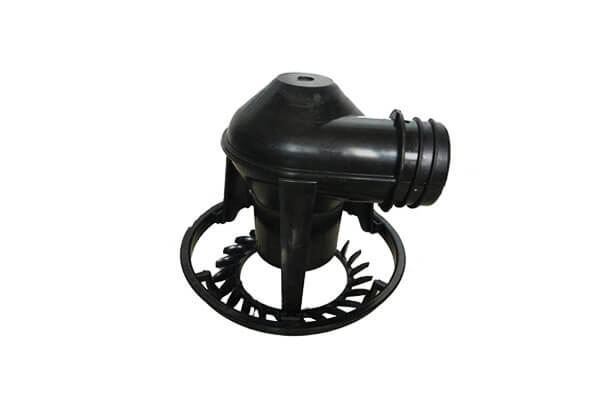
- Applications: Cooling nozzles are commonly used in power plants, industrial manufacturing plants,
and aerospace applications, where components such as turbines, reactors, and engines must be kept within safe operating temperatures.
These nozzles often employ advanced cooling techniques like regenerative cooling (using fluid to cool the nozzle itself before combustion)
and film cooling (where a thin layer of fluid protects nozzle surfaces from heat).
Design Considerations: The design of cooling nozzles must take into account the temperature and flow rate of the cooling fluid,
the surface area of the nozzle, and the cooling capacity needed for the system.
Pressure Relief Nozzles
Pressure relief nozzles are used in systems that involve high-pressure fluids, such as hydraulic systems, pressure vessels, and safety valves.
These nozzles help regulate pressure within a system, preventing over-pressurization and ensuring safety.
- Applications: Pressure relief nozzles are critical in industries like oil and gas, chemical processing, and power generation.
They are commonly used in pressure relief valves to prevent systems from reaching dangerous pressure levels, thereby ensuring the integrity and safety of the system.
Design Considerations: These nozzles are designed to withstand extreme pressures without failing, requiring robust materials and precise engineering to maintain system stability.
Specialty Nozzles
Specialty nozzles are engineered for specific applications that require highly specialized fluid control. These nozzles may include unique features tailored to a particular industry or function.
Applications:
- Cleaning Nozzles: These nozzles are designed for high-pressure washing and cleaning applications.
They are commonly used in industrial settings, where high-pressure water or chemicals are needed for surface cleaning. - Firefighting Nozzles: Firefighting nozzles are designed to control the flow of water or fire-suppressant foam in emergencies.
These nozzles often have adjustable spray patterns to optimize fluid delivery during firefighting operations.Firefighting Nozzles - Fuel Injection Nozzles: Found in engines, fuel injection nozzles are designed to deliver precise amounts of fuel into combustion chambers.
They play a crucial role in optimizing combustion efficiency, reducing emissions, and improving engine performance.Fuel Injection Nozzles - Agricultural Nozzles: These nozzles are designed for specific tasks such as spraying pesticides, fertilizers, or herbicides.
Many agricultural nozzles are equipped with adjustable spray patterns to accommodate varying field conditions and ensure efficient use of resources.Agricultural Nozzles
4. Materials Used in Nozzle Manufacturing
The selection of materials for nozzle manufacturing is critical to the nozzle’s performance, longevity, and durability under specific operating conditions.
Different applications, whether they require high temperature resistance, corrosion resistance, or the ability to withstand extreme pressure, demand distinct material characteristics.
Below, we explore the key materials used in nozzle manufacturing, detailing their properties, advantages, and ideal applications.
Stainless Steel
Stainless steel is one of the most commonly used materials for nozzles due to its combination of excellent strength, corrosion resistance, and high-temperature performance.
It is suitable for a wide range of applications where the nozzle is exposed to challenging environments, such as in industrial cleaning, aerospace, and fuel injection systems.
Inconel (Nickel-Chromium Alloy)
Inconel alloys are a family of high-performance, nickel-chromium-based superalloys.
They excel in extreme environments, especially in aerospace, gas turbines, and other high-stress applications due to their exceptional resistance to high temperatures and corrosion.
Titanium
Titanium and its alloys are known for their lightweight yet strong properties, making them ideal for applications that prioritize weight reduction without sacrificing performance.
It offers superior corrosion resistance, particularly in harsh marine and aerospace environments.
Ceramic Materials
Advanced ceramics, such as alumina (Al2O3), zirconia (ZrO2), and silicon carbide (SiC), offer excellent hardness, wear resistance, and thermal stability.
These materials are typically used in nozzles that must withstand extremely high temperatures or abrasive conditions.
Carbon Steel
Carbon steel is often used for nozzles in moderate pressure and temperature applications.
It provides an affordable option for applications that do not require advanced material performance, such as basic industrial processes and water treatment.
High-Performance Polymers (e.g., PTFE, PEEK)
Polymers like PTFE (polytetrafluoroethylene) and PEEK (polyetheretherketone) are known for their resistance to chemicals, high temperatures, and friction.
These materials are used when a nozzle needs to withstand corrosive environments or high wear while providing precision flow control.
Hastelloy
Hastelloy is a nickel-based alloy designed for use in severe chemical and high-temperature environments.
Its resistance to corrosion and high performance in extreme conditions make it the material of choice for highly specialized nozzle applications.
Copper Alloys
Copper alloys, such as brass and bronze, are valued for their excellent thermal conductivity and moderate corrosion resistance.
These alloys are ideal for applications that require efficient heat dissipation and high electrical conductivity.
Table: Comparison of Nozzle Materials
| Material | Advantages | Applications | Typical Use Cases |
|---|---|---|---|
| Stainless Steel | Corrosion resistance, strength at high temps | Agricultural spray nozzles, industrial cleaning nozzles | Industrial cleaning, fuel injectors, pressure relief nozzles |
| Inconel | High temperature, oxidation resistance | Aerospace, gas turbines, rocket engine nozzles | Jet nozzles, rocket propulsion, power generation nozzles |
| Titanium | Lightweight, corrosion resistance, heat resistant | Aerospace, marine, chemical processing nozzles | Aerospace propulsion, marine cooling, chemical processing |
| Ceramic Materials | Hardness, wear resistance, thermal stability | High-performance combustion systems, waterjet cutting nozzles | Gas turbines, cutting nozzles, high-temp industrial cooling |
| Carbon Steel | Cost-effective, good strength | Industrial processes, water treatment systems | Basic industrial spraying, pressure relief nozzles |
| High-Performance Polymers (PTFE, PEEK) | Chemical resistance, low friction, high temperature stability | Chemical processing, automotive fuel injectors | Chemical reactors, fuel injectors, medical devices |
| Hastelloy | Corrosion resistance, strength under extreme conditions | Chemical processing, marine desalination | Chemical reactors, marine desalination, aerospace |
| Copper Alloys | Thermal conductivity, machinability | Cooling systems, automotive, electrical nozzles | Heat exchangers, fuel injectors, electrical components |
5. Key Benefits of Using Nozzles
Nozzles are essential components in a wide range of industrial processes, offering various advantages that enhance operational efficiency, precision, and safety.
The design and function of nozzles allow industries to control fluid flow, pressure, and velocity in a highly controlled manner, leading to improved performance across multiple sectors.
Below are the key benefits of using nozzles:
Precise Control Over Fluid Flow
One of the most significant advantages of nozzles is their ability to control the flow rate of liquids, gases, or steam.
By adjusting the nozzle design, operators can regulate the amount of fluid passing through, ensuring that it meets the specific requirements of the application.
This precision is particularly beneficial in industries like agriculture, automotive, and manufacturing, where accurate fluid delivery is crucial for achieving optimal results.
- Example: In automotive fuel injectors, nozzles regulate the fuel flow into the combustion chamber, ensuring precise mixing with air to optimize combustion efficiency and reduce emissions.
Enhanced Efficiency in Fluid Distribution
Nozzles are designed to optimize fluid distribution, ensuring uniform coverage and minimizing waste.
By selecting the right nozzle type and pattern, industries can achieve consistent results while reducing the amount of material used.
This is especially important in applications such as spraying, irrigation, and coating, where efficiency plays a critical role in minimizing costs and maximizing productivity.
- Example: In agriculture, spray nozzles ensure an even distribution of pesticides or fertilizers, reducing the likelihood of chemical runoff and increasing crop yield.
Energy and Cost Savings
In many industrial applications, nozzles help to maximize energy efficiency by controlling the flow of gases or fluids in ways that reduce energy consumption.
For example, nozzle designs that optimize combustion efficiency can lead to significant energy savings in power generation and industrial heating processes.
Additionally, nozzles can help reduce material waste, resulting in long-term cost savings.
- Example: Burner nozzles used in combustion systems help to ensure efficient fuel usage, lowering energy consumption and minimizing emissions.
This leads to both environmental and cost benefits for industries like manufacturing and power generation.
Improved Safety and Reliability
Nozzles play a vital role in improving safety in various industrial settings by controlling fluid pressures and preventing dangerous overflows or leaks.
Pressure relief nozzles, for instance, are crucial in hydraulic systems and pressure vessels, where they manage excess pressure to prevent failures.

By controlling the release of fluids and gases, nozzles also help mitigate the risk of accidents and enhance system reliability.
- Example: Pressure relief nozzles in hydraulic systems ensure that pressure is maintained at safe levels, preventing system failure or potential accidents in heavy machinery.
Enhanced Performance in Specialized Applications
In many cases, nozzles are tailored to meet the specific demands of high-performance applications, ensuring that systems operate optimally under challenging conditions.
This includes nozzles designed for high-temperature environments, such as those used in aerospace propulsion, or for high-pressure systems, as seen in fire-fighting equipment.
By adapting the nozzle design to meet the unique requirements of an industry, manufacturers can achieve superior results.
- Example: In rocket propulsion systems, specialized jet nozzles, such as the converging-diverging de Laval nozzles,
are designed to accelerate exhaust gases to supersonic speeds, generating the necessary thrust to propel rockets into space.
Customization for Specific Needs
Another significant benefit of nozzles is their ability to be customized for unique or niche applications.
Industries that require specialized fluid handling solutions can design nozzles with specific shapes, materials, and spray patterns to suit their needs.
Custom nozzles allow for more precise control over fluid dynamics, ensuring optimal performance in highly specialized operations.
- Example: In the chemical processing industry, custom-designed nozzles made from corrosion-resistant materials
like Hastelloy or PTFE are used to handle aggressive chemicals safely and efficiently.
Contribution to Sustainability
In recent years, there has been a growing emphasis on sustainability, and nozzles play a crucial role in reducing environmental impact.
Precision spraying and atomization technologies help to reduce material waste,
such as in agricultural spraying or paint applications, while also limiting the release of harmful substances into the environment.
Nozzles can also facilitate more efficient energy use, reducing the carbon footprint of industrial operations.
- Example: Precision irrigation nozzles reduce water waste by ensuring that water is delivered directly to plant roots, promoting sustainable farming practices.
Ease of Maintenance and Longevity
Nozzles, when designed with durable materials and built to withstand specific operational conditions, can last for extended periods without significant wear and tear.
Many nozzle designs are also easy to maintain and clean, which helps reduce downtime and operational costs.
Regular maintenance, such as cleaning spray nozzles or replacing worn components, ensures that nozzles perform at their best over time.
- Example: Spray nozzles used in industrial cleaning systems are designed for easy maintenance,
reducing the need for costly replacements and ensuring consistent performance over their lifespan.
Improved Environmental Control
Nozzles also help in environmental control by ensuring efficient fluid dispersion in applications like air conditioning systems, water treatment, and cooling towers.
By regulating fluid flow and ensuring consistent distribution, nozzles contribute to better environmental conditions in both industrial and residential settings.
- Example: In HVAC systems, nozzles are used to distribute refrigerant evenly, helping to maintain optimal temperatures and improve energy efficiency in cooling systems.
6. Applications of Nozzles
Nozzles are used across various industries:
- Aerospace and Aviation: Nozzles in jet engines and rockets help control exhaust flow, generate thrust, and ensure optimal engine performance.
- Automotive Industry: Fuel injectors and nozzles in engines enhance combustion efficiency and reduce emissions.
- Manufacturing and Coating: Nozzles are essential for precision painting, powder coating, and additive manufacturing.
- Agriculture: Agricultural nozzles are used for pesticide spraying, irrigation, and fertilization, ensuring efficient water and chemical use.
- Firefighting and Water Systems: Nozzles are used to control water flow in firefighting, cooling, and cleaning applications.
7. Manufacturing Techniques of Nozzles
As nozzle performance directly impacts efficiency, safety, and environmental compliance, the manufacturing techniques used must meet strict quality standards and performance specifications.
Precision Machining
Precision machining remains one of the most widely used techniques for manufacturing nozzles, especially for applications requiring high accuracy and durability.
It involves the removal of material from a workpiece to achieve the desired shape, size, and surface finish.
Additive Manufacturing (3D Printing)
Additive manufacturing, or 3D printing, is increasingly being adopted for nozzle production,
especially for creating highly complex geometries that cannot be easily achieved using traditional methods.
3D printing works by building up material layer by layer, which allows for the creation of intricate nozzle designs with optimal flow paths.
Investment Casting
Investment casting is another manufacturing method used for producing nozzle, especially for high-volume production.
The casting process involves pouring molten material into a mold and allowing it to cool and solidify.
Investment casting is often used for creating nozzle components with complex shapes that would be difficult to machine.
8. Standards and Regulations
As nozzles are critical components in various industries, their design and performance must adhere to stringent industry standards and regulations.
These standards ensure that nozzles meet safety, performance, and environmental requirements.
Industry Standards
Nozzles must comply with several industry standards to ensure consistent quality and performance across applications. Common standards include:
- ASME (American Society of Mechanical Engineers): ASME standards, particularly in pressure vessels and nozzles,
ensure that designs are safe and capable of withstanding extreme conditions. - ISO (International Organization for Standardization): ISO standards help ensure global uniformity in nozzle performance testing, materials, and manufacturing processes.
These standards provide guidelines for nozzle size, pressure testing, and flow rates. - ASTM (American Society for Testing and Materials): ASTM specifications define the materials, testing,
and performance requirements for nozzles in various applications, including agriculture, automotive, and aerospace.
Environmental Compliance
In addition to industry standards, nozzles must adhere to environmental regulations aimed at reducing their environmental impact:
- EPA (Environmental Protection Agency): The EPA sets regulations on emissions control nozzles,
particularly in combustion and industrial systems, to reduce pollutants released into the atmosphere.
Nozzles designed for fuel combustion, such as burner nozzles, must meet strict standards for emission reductions. - REACH (Registration, Evaluation, Authorization, and Restriction of Chemicals): REACH regulations govern the use of hazardous substances in nozzle materials.
Manufacturers must ensure that nozzle made from specific metals or chemicals do not pose risks to human health or the environment.
9. Innovations and Future Trends
Nozzle technology is evolving rapidly, driven by advancements in manufacturing techniques, material science, and the growing demand for sustainable solutions.
Advanced Manufacturing
Additive Manufacturing
Additive manufacturing is enabling the production of more complex and optimized nozzle geometries that were previously impossible with traditional methods.
This includes lattice structures that reduce material use while maintaining strength and functionality.
As this technology evolves, it will likely lead to more lightweight and efficient nozzle in industries such as aerospace and automotive.
Hybrid Materials
The use of hybrid materials—such as ceramic-metal composites—offers the potential for nozzles to withstand extreme conditions.
These materials combine the heat resistance of ceramics with the mechanical strength of metals,
allowing for the creation of high-performance nozzle for rocket propulsion systems and industrial furnaces.
Smart Nozzles
IoT-Enabled Nozzles
Internet of Things (IoT)-enabled nozzles are revolutionizing industries by allowing real-time monitoring and control of fluid flow.
Sensors embedded in nozzles can measure flow rates, pressure, and temperature, transmitting data to centralized control systems for optimized performance.
This technology improves efficiency, ensures precise control, and helps in predictive maintenance.
Adaptive Designs Using Shape-Memory Alloys
Shape-memory alloys (SMAs) allow for the development of adaptive nozzles that can change shape in response to environmental conditions (e.g., temperature or pressure).
These smart nozzles can optimize fluid flow automatically, improving performance in dynamic systems such as jet engines and rocket propulsion.
Sustainability
Sustainability is becoming an increasingly important consideration in nozzle design and manufacturing:
Hydrogen Fuel Systems
With the growing demand for green energy solutions, nozzles for hydrogen fuel systems are a key area of development.
These nozzles are designed to handle hydrogen’s unique properties and ensure efficient
delivery into fuel cells or combustion engines, contributing to the transition toward sustainable energy sources.
Precision Spraying and Reduced Material Waste
In agriculture, automotive painting, and other industries, precision nozzles are helping to minimize material waste by delivering fluids in the most efficient manner possible.
These nozzles reduce overspray, improve material utilization, and contribute to more sustainable production processes.
10. Nozzles vs. Other Fluid Control Devices
When it comes to fluid control, nozzles are just one of many devices used to regulate the flow, direction, pressure, and velocity of liquids and gases.
While nozzles are highly specialized for certain applications, other fluid control devices, such as valves, regulators, and pumps, serve different roles in fluid systems.
Understanding the differences between nozzles and these devices can help determine which technology is most suitable for specific tasks.
Comparison of Nozzles vs. Other Fluid Control Devices
| Device Type | Primary Function | Design and Applications | Advantages | Limitations |
|---|---|---|---|---|
| Nozzles | Control flow direction, velocity, and shape of fluid. | Fuel injectors, spray nozzles, jet propulsion systems. | High precision in directing and atomizing fluid. | Cannot move fluids through a system (no pumping capability). |
| Valves | Regulate or stop the flow of fluids. | Ball, gate, butterfly, and check valves in piping systems. | Excellent for stopping, starting, or throttling flow. | Cannot shape or direct fluid flow like nozzles. |
| Regulators | Maintain constant fluid pressure. | Gas regulators, water pressure regulators in pipelines. | Essential for maintaining constant pressure. | Cannot control fluid direction or velocity like nozzles. |
| Pumps | Move fluids through a system by increasing pressure. | Centrifugal, piston, diaphragm pumps in fluid transfer systems. | Necessary for fluid movement over long distances. | Do not control fluid direction or characteristics. |
| Diffusers | Slow down the fluid and increase its pressure. | Used in gas turbines, air conditioning systems. | Increases fluid pressure while decreasing velocity. | Do not accelerate fluid or increase flow velocity. |
| Filters | Remove impurities or particles from fluid. | Water treatment plants, pharmaceutical filtration systems. | Crucial for ensuring clean fluid before use. | Do not influence fluid direction or velocity. |
11. Conclusion
Nozzles play a fundamental role in a broad range of industries, with their design, functionality, and material selection directly impacting the efficiency and safety of fluid-based systems.
Whether used for controlling exhaust gases in jet engines or distributing pesticides across farmland, nozzles remain crucial for optimizing fluid dynamics.
As industries continue to advance, innovations in nozzle technology will further enhance performance, reduce environmental impact, and ensure sustainability across sectors.
For premium-quality nozzles tailored to your requirements, LangHe provides investment casting, precision machining, and rigorous quality assurance.
Contact us today to explore our comprehensive nozzle solutions!

